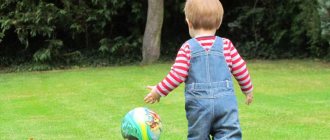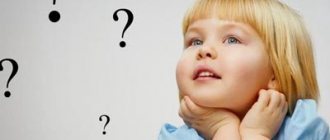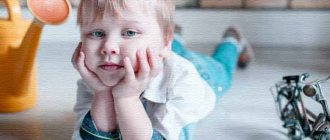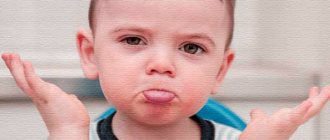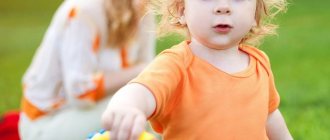What should a two-year-old child be able to do according to the Munich Diagnostic System?
For parents who want to know the norms of psychomotor development of children under 3 years of age, it is useful to get acquainted with the Munich functional development diagnostic system. It was developed in 1997 and includes practical indicators of child development. According to this diagnosis, by the age of two years the baby should be able to:
- Walk on tiptoes without adult assistance;
- Stand on one leg for a short time;
- Jump;
- Go up and down stairs while holding the railing;
- Open doors;
- Unscrew and tighten the caps;
- String large beads onto a cord;
- Build towers from cubes;
- Throw and roll the ball;
- Name animals;
- Name parts of the body;
- Sort by color, size and shape;
- Correlate the image in the picture with the real object;
- Sing songs;
- Speak in short phrases;
- Play with peers;
A two-year-old child is already quite independent. The baby already has quite well developed coordination, he is constantly in motion. With the help of adults, a two-year-old can easily take care of himself: go to the potty, drink from a cup, eat with a spoon, wash and dry his hands, undress. Support your child's initiative and give him freedom - this way he will quickly learn to be independent.
Norms for child speech development at 3 years old
In the period from 2 to 3 years, vocabulary increases from 50 to 1500 words, and fragmentary messages are transformed into detailed sentences. Can you imagine how quickly a child’s brain “absorbs” and remembers information?!
At the age of 3 years, a child is normally able to listen to an oral narrative (fairy tale) for 5-10 minutes and follow the plot. In addition, by the age of 3, the function of rapid word creation is activated: the child begins to build non-existent words from familiar parts, combining incompatible roots, suffixes and prefixes. He begins to sparkle with funny children's words like “zucchini” (a cross between a zucchini and a dog), “elephant” (an elephant with a sunflower), etc.
At the same time, self-esteem begins to actively develop, so messages from the third person (“Masha won’t sleep”) are gradually replaced by statements from the first (“I’m going for a walk”).
Is there something wrong?
- the child speaks in sentences, but grossly violates grammatical agreement (instead of “I don’t want” - “Masha wants no”);
- lack of first-person messages: instead of I - still a proper name;
- during speaking, the tip of the tongue protrudes between the teeth, sounds are pronounced through the nose.
Development of fine motor skills at 2 years
It is known that improving fine motor skills is closely related to the intellectual and speech development of the baby. At the age of 2 years, children are especially interested in playing with small objects, rearranging them, sorting them, and stringing beads. Most often, it is at this age that the child’s leading hand is determined, but it is useful to do all the exercises with both hands (one at a time and simultaneously). You can get ideas for developing your baby's fine motor skills from this video:
Development of perception in two-year-old children
If in the process of movement the baby explores the capabilities of his body, then with the help of perception (vision, hearing, smell, touch, taste) the child learns about the world around him.
- Vision . It is through vision that children, like adults, receive most information about the world. Children at the age of 2 already have good visual coordination and are able to follow a moving object with their eyes and distinguish between horizontal and vertical lines. However, they cannot yet simultaneously perceive the whole and the parts, so if the baby is in a crowd, it will be difficult for him to quickly detect his adult.
- Rumor . It is worth paying attention to the child’s auditory perception, since if there are hearing problems, the baby will most likely experience difficulties in speech development. At 2 years old, a child should be able to distinguish intonation well and understand simple requests.
- Taste and smell . For some reason, in our culture, practically no attention is paid to the role of these analyzers in a child’s exploration of the world. At the same time, in France, the development of taste buds is considered an important stage in the psycho-emotional development of a child.
- Touch . Tactile contact with significant adults is very important for the mental and physical health of the baby. It is thanks to him that children develop trust in the world, a sense of security and love. In early childhood, tactile perception of objects is on a par with visual perception. Babies acquire ideas about such concepts as cold/hot, hard/soft, smooth/rough thanks to tactile sensitivity.
For the development of a 2-year-old child, it is very important that the baby receives as many impressions as possible. It is desirable that information be obtained from different sources. In the nursery, for the harmonious development of children, a Montessori environment is organized, from which every child can learn exactly what he needs at the moment.
Features of speech development of children 2–3 years old
A two-year-old child has already mastered speech to such an extent that he can talk about his impressions, explain what he needs, and establish communication with peers and adults.
The normal development of a child’s speech at 2 years old leads to the fact that by the age of 2.5 years his vocabulary ranges from 1 thousand to 1200 words. This amount is 3-4 times more than the vocabulary with which he arrived at two years old. Most often he uses nouns (60% of the total vocabulary) and verbs (on average 25% of the total number of words). There are adjectives (about 10%), pronouns, prepositions, and adverbs.
Two-year-old children use participles, gerunds and numerals less often. By adjectives, child means:
- size of objects (large, small);
- color (green, red, blue, yellow, white, black);
- properties of objects (sweet, sour, cold, hot);
- qualities (good, bad);
- shape (round, square, triangular).
Generalizing words, such as toys, fruits, vegetables, clothes, furniture, dishes, animals, actively appear in the baby’s speech. He can also confuse objects from the same group, calling shoes and boots, and slippers, and even short boots, or the very concepts of vegetables and fruits. Lighter words (bi-bi instead of the word car) are becoming less and less common in a child’s speech.
Word creativity is actively developing, the baby comes up with words himself. Proof that at this age children are able to understand the sound side of a word can be seen in the textbook example given by Korney Chukovsky in his book “From Two to Five”: mazelin - Vaseline, mocress - compress.
Grammatical features of speech
The main content of children's speech at this age is simple narrative or exclamatory sentences. Complex sentences appear infrequently; their examples should be given in their speech by the baby’s parents. For example, “we won’t go for a walk today because it’s raining,” or “now we’ll read a book and then we’ll sleep.” Words in sentences in children of the third year of life are consistent in gender and number, but errors in case endings are often encountered.
Interrogative sentences are still asked by intonation, although children at this age are already able to use question words: where, why, when, how. You can suggest to your child: “Ask grandma where the car is?”, “Ask dad why the tea is hot?”, thereby giving examples of interrogative sentences.
Sound pronunciation
In the third year of a child’s life, the organs of pronunciation have become significantly stronger, the muscles of the tongue, lips, and lower jaw work more harmoniously. However, in the sound pronunciation of two-year-olds there are often many difficulties encountered, although the kids try to bring it as close as possible to the speech that sounds around them.
Most often, the pronunciation of hissing sounds suffers, which are replaced by whistling sounds, as they are easier in articulation (kasya - porridge, syapka - hat, koska - cat). Hard sounds can be replaced by soft ones (lapa - lyapa, dai - dyai), when consonants coincide, one of them is not pronounced, falls out, especially if these are sounds such as sh, zh, shch, ts, ch, l, r (stay - that , grass - tavka).
The child shortens words of 3-4 syllables, swaps syllables, and skips individual sounds, although in simple words he pronounces the same sounds flawlessly. The differences between the sound pronunciation of children of the same age by this period can be very significant. By the age of 3, some children master all the sounds of their native language, even the difficult-to-articulate sound p, while others have unclear speech with the absence of most sounds or no speech at all.
Personal hygiene skills
A two-year-old child is already quite independent, and many parents strive to instill in their child the skills of self-care and personal hygiene. If you approach this issue wisely, then at 2 years old the child will be able to independently:
- Wash;
- To wash hands;
- Brush your teeth;
- Go potty.
Potty training is a challenge for many. Some try to force a child to sit on the potty, while others do not attach much importance to this skill. Scientists have found that children themselves begin to strive to go to the potty at the age of 1.5 - 2.5 years. Until this time, babies are just learning to control their intestines and bladder. Therefore, under no circumstances should you scold your child for “wet matters.” If the child himself wants to go to the potty, be sure to encourage this, praise any attempt by the child to control his body and be patient. Some people potty train quickly, while others constantly pee in their pants at 2 years old, but this is not a deviation from the norm. Be patient and your baby will definitely learn to go potty.
Signs of speech delay
After two years, some children cannot use speech as a means of communication due to the fact that children’s speech development is delayed. The cause of concern for their parents is the complete absence of speech or a limited number of available words. In addition to a poor vocabulary, speech development delay (SDD) is expressed by the following symptoms:
- the child cannot translate his thought into a speech message, he finds it difficult to answer an adult’s questions;
- active and passive vocabulary accumulate at a very slow pace;
- children have difficulty constructing even a short phrase: “The girl’s ball fell or the girl’s ball” (The girl’s ball fell);
- Children cannot not only build a common sentence on their own, but also repeat it after an adult, for example, Teddy bear came out of the forest;
- in spoken words there are often rearrangements of syllables and sounds, substitution of one sound for another;
- when pronouncing individual sounds, the child notices tension or twitching of the facial muscles;
- he does not understand the meaning of a fairy tale or nursery rhyme read by an adult, and finds it difficult to answer a simple question about its content or try to retell it;
- The baby has difficulty assembling nesting dolls, cubes, and cut-out pictures consisting of four parts.
Expert opinion
Buynova Nadezhda Valerievna
Pediatric speech therapist, experience over 20 years
The causes of these disorders can be both structural defects of the speech apparatus and pathological deviations from the norm of brain structures. A healthy child may have speech development disorders due to improper upbringing, when they communicate with him little and do not pay attention to his speech development. Incorrect pronunciation of many sounds by adults and “lisping” with a child can cause functional speech delay.
